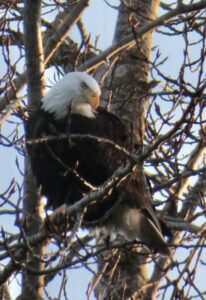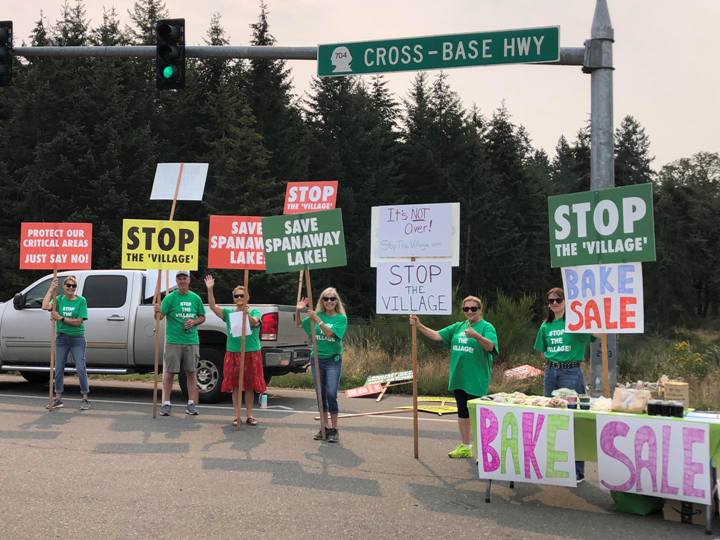by Kirk Kirkland
The most interesting testimony at the recent appeal of the Pierce County Fill and Grade Permit for the Spanaway Marsh was about the bald eagles’ nest there.
Eagles have a lifespan of up to 70 years and mate for life. These two have nested in the Spanaway Marsh for at least 23 years. It’s not unusual to see them soaring over Spanaway and Parkland or catching a fish in their talons from any one of the creeks or lakes. US Army wildlife biologists have documented that this eagle pair has nurtured 31 nestlings.
Bald eagles were initially listed as a federally endangered species in 1967. Forty years later, in 2007, bald eagles were delisted from the ESA, and in 2017 were delisted from Washington State’s endangered list. Despite delisting, bald eagle foraging areas (within one-half mile of the nest and 250 feet of shorelines) are protected by the United States Fish and Wildlife Service (USFWS) as a Monitored Species and are protected under the Migratory Bird Treaty Act (Department of the Interior, 2013).
Eagles and their habitats are supposedly protected under Pierce County Code 18E.40.020, too. The army closes Spanaway Marsh and other wetlands areas on Fort Lewis during the eagles’ nesting and fledging time of January through July.
In November 2022, December 2023, and April 2023, Soundview Consultants, an environmental consulting firm specializing in natural and aquatic resource assessments, investigated the property near the nest for the presence of eagles, to review the quality of the wetlands habitat, and for presence of fish and other wildlife habitat. Soundview acknowledged the presence of multiple WDFW Priority Habitats and documented the presence of federally protected species, including eagles and steelhead.

Soundview wrote, ”nesting sites are regulated as a Federal Fish & Wildlife Conservation Area that includes Oregon white oak stands, one bald eagle nest. Salmonid are present within Wetland A and Spanaway Creek and Coffee Cre.ek. These protection areas are outlined in PCC 18E.40.040.”
According to exhibits 105 &106 of the USFWS and WDFW maps that highlight the areas of significance, consultants also found that “Bald eagle foraging areas extend 0.5-mile from the center of the nest in either direction along the shoreline and 250 feet landward, however, no protective buffer is identified.”

At the Administrative Hearing, the Hearing Examiner ruled the “Clearing and Grading within the 75 feet of an eagle nesting tree also violates the state Department of Fish and Wildlife regulations. The applicant clearly needed to obtain permits from the USFWS.”
The Hearing Examiner further wrote: “The applicant and the Planning Department staff agree with Spanaway Concerned Citizens that violations of regulations enforced by the Washington Department of Fish and Wildlife occurred,” but at the same time he denied any violation of US Fish and Wildlife Service regulations related to eagle protection. “The Pierce County Code is replete with code sections designed to obtain code compliance as opposed to punishment such as revocation of permits or project approval.”
But despite all this, the Hearing Examiner concluded he does not have the authority to revoke or punish the applicant. “The Planning Department staff (PPW) have written orders and require … corrective action … but do not mention revocation of a permit.” And, “in the present case the applicant has either resolved violations or is actively in the process of doing so to the satisfaction of the planning department.”
“The site development permit will include…approval of engineering and environmental mitigation plans and will clearly identify the unpermitted work and proposed mitigation.” And therefore, “the PPW is fulfilling the county’s goals of obtaining compliance, and acted appropriately in not withdrawing a previously issued permit.”
The Hearing Examiner’s decision shows the weakness in county code which allows the applicant to work within the boundaries of the eagles’ nest as long as he applies for a permit. The county will not prevent further tree removal or harm to the understory. No effort is made to provide mitigation that could return eagles to the nest.
The law assumes that any amount of damage done to the habitat can be mitigated even the removal of 900 trees and their understory that is important to wildlife. So, while bald eagles are mentioned in the Pierce County Code, ultimately, the code offers no protection for eagles’ nests and their habitats.
Kirk Kirkland has appeared before the Pierce County Hearing Examiner for over 25 years. He has only won two appeals: one when the examiner allowed a golf course resort to be built in a county designated volcanic hazard area, and the other when the examiner failed to revoke a permit when the golf course resort applicant did not comply with conditions of the permit. The costs of these two appeals was over $80,000.


